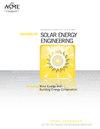Assessment of Bulk Oxygen Capacity and Transient Redox Behavior of Foamed LSM Perovskites
IF 1.9
4区 工程技术
Q3 ENERGY & FUELS
Journal of Solar Energy Engineering-transactions of The Asme
Pub Date : 2023-09-27
DOI:10.1115/1.4063440
引用次数: 0
Abstract
Abstract Synthesis of solar thermochemical hydrogen (STCH) production redox materials with engineered structures, for example, replica foams, can enable efficient heat and mass transport and are critical for scaled-up systems. Prior work has motivated the use of lanthanum strontium manganese (LSM)-type perovskites as foamed STCH materials, but the effect of their morphology on bulk and kinetic behavior has not been reported. In this work, replica and direct foamed samples of La0.65Sr0.35MnO3-δ (LSM35) were fabricated and compared to synthesized powders and dense monoliths, and similarly synthesized CeO2-δ (ceria) foams, regarding their specific reaction rates and bulk oxygen capacity/H2 yields. Changes in oxygen capacity (Δδ) and reaction rates were measured between 1200 °C and 1400 °C by using fixed ratios of steam and hydrogen during both reduction and oxidation steps, allowing for analysis under practical high conversion conditions. Results suggest bulk behavior and reaction rates of the foamed LSM materials are comparable to their powder analogues. Differences in reaction rates were observed only when replica foamed samples were subjected to rapid laser heating (emulating conditions expected in solar furnaces), which is expected but has not been demonstrated at such a small scale. Foamed samples were further subjected to 50 redox cycles at 1400 °C to evaluate their stability. Results show no statistically significant decrease in hydrogen production for any of the foamed samples, but the direct foamed samples became brittle with time. Together, these results demonstrate the viability of replica foamed LSM perovskites for integration in scaled-up STCH systems.泡沫LSM钙钛矿体氧容量及瞬态氧化还原行为的评价
利用工程结构合成太阳能热化学氢(STCH)生产氧化还原材料,例如复制泡沫,可以实现有效的热量和质量传输,对于放大系统至关重要。先前的研究已经推动了使用镧锶锰(LSM)型钙钛矿作为泡沫STCH材料,但其形貌对体积和动力学行为的影响尚未报道。在这项工作中,制备了La0.65Sr0.35MnO3-δ (LSM35)的复制和直接泡沫样品,并将其与合成的粉末和致密单体以及类似合成的CeO2-δ (ceria)泡沫进行了比较,比较了它们的比反应速率和体积氧容量/H2产率。通过在还原和氧化步骤中使用固定比例的蒸汽和氢,在1200°C和1400°C之间测量了氧容量(Δδ)和反应速率的变化,允许在实际的高转化条件下进行分析。结果表明,泡沫LSM材料的体积行为和反应速率与其粉末类似物相当。反应速率的差异仅在泡沫样品的复制品受到快速激光加热(在太阳炉中模拟条件)时观察到,这是预期的,但尚未在如此小的规模上得到证明。泡沫样品进一步在1400°C下进行50次氧化还原循环以评估其稳定性。结果表明,任何泡沫样品的产氢量都没有统计学上的显著下降,但直接泡沫样品随着时间的推移变得脆性。总之,这些结果证明了复制泡沫LSM钙钛矿在放大STCH系统中集成的可行性。
本文章由计算机程序翻译,如有差异,请以英文原文为准。
求助全文
约1分钟内获得全文
求助全文
来源期刊
CiteScore
5.00
自引率
26.10%
发文量
98
审稿时长
6.0 months
期刊介绍:
The Journal of Solar Energy Engineering - Including Wind Energy and Building Energy Conservation - publishes research papers that contain original work of permanent interest in all areas of solar energy and energy conservation, as well as discussions of policy and regulatory issues that affect renewable energy technologies and their implementation. Papers that do not include original work, but nonetheless present quality analysis or incremental improvements to past work may be published as Technical Briefs. Review papers are accepted but should be discussed with the Editor prior to submission. The Journal also publishes a section called Solar Scenery that features photographs or graphical displays of significant new installations or research facilities.

 求助内容:
求助内容: 应助结果提醒方式:
应助结果提醒方式:


